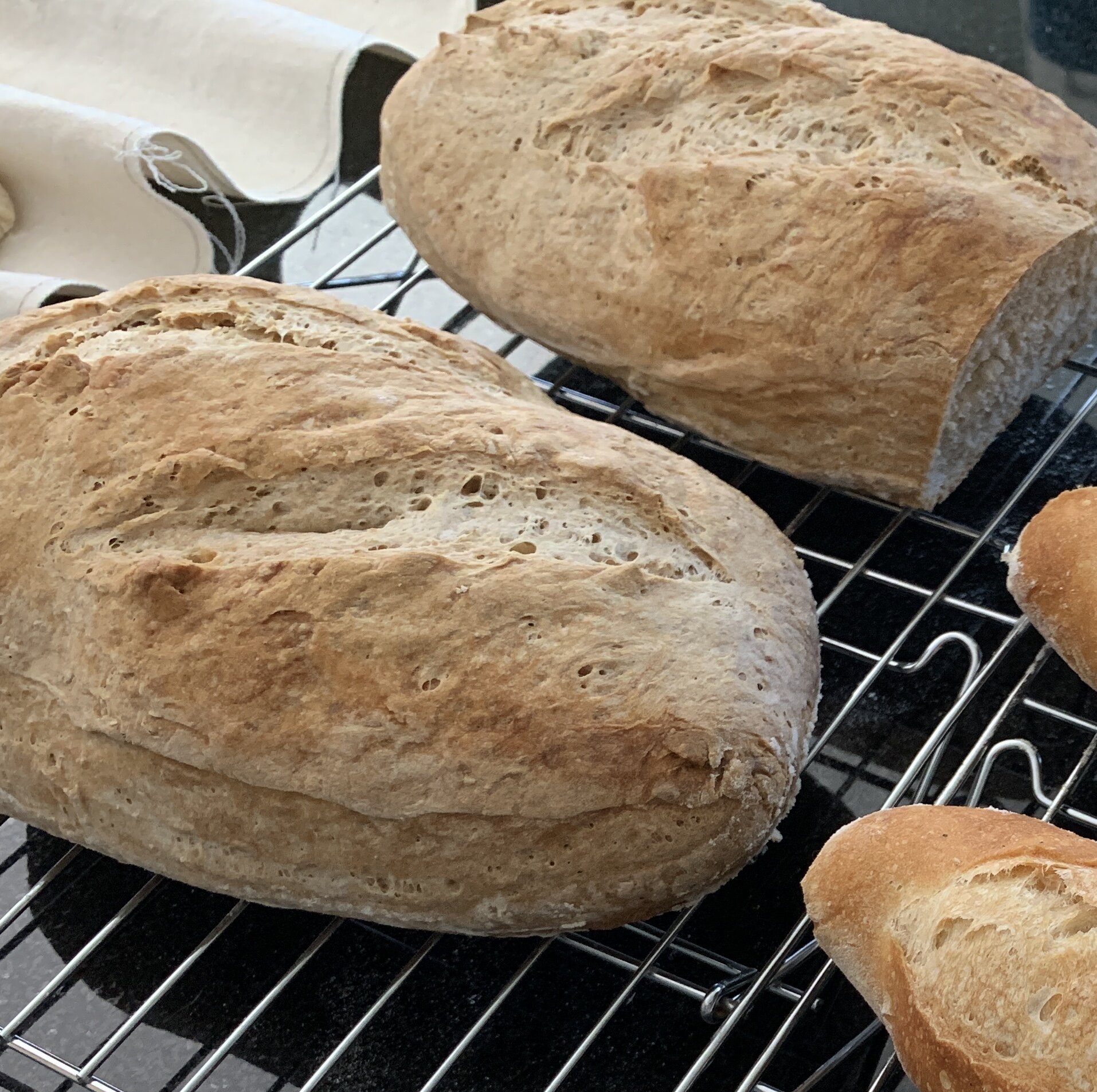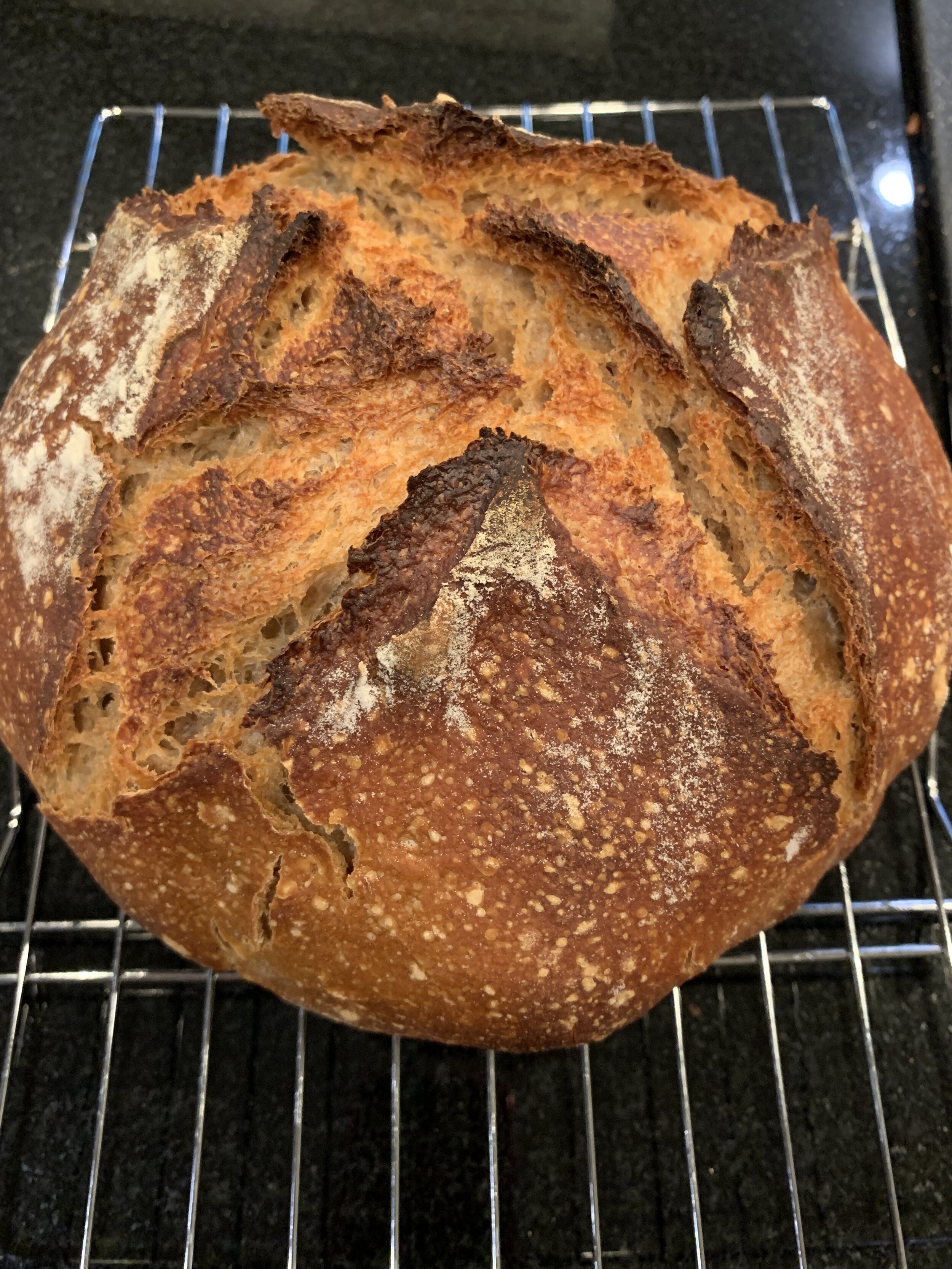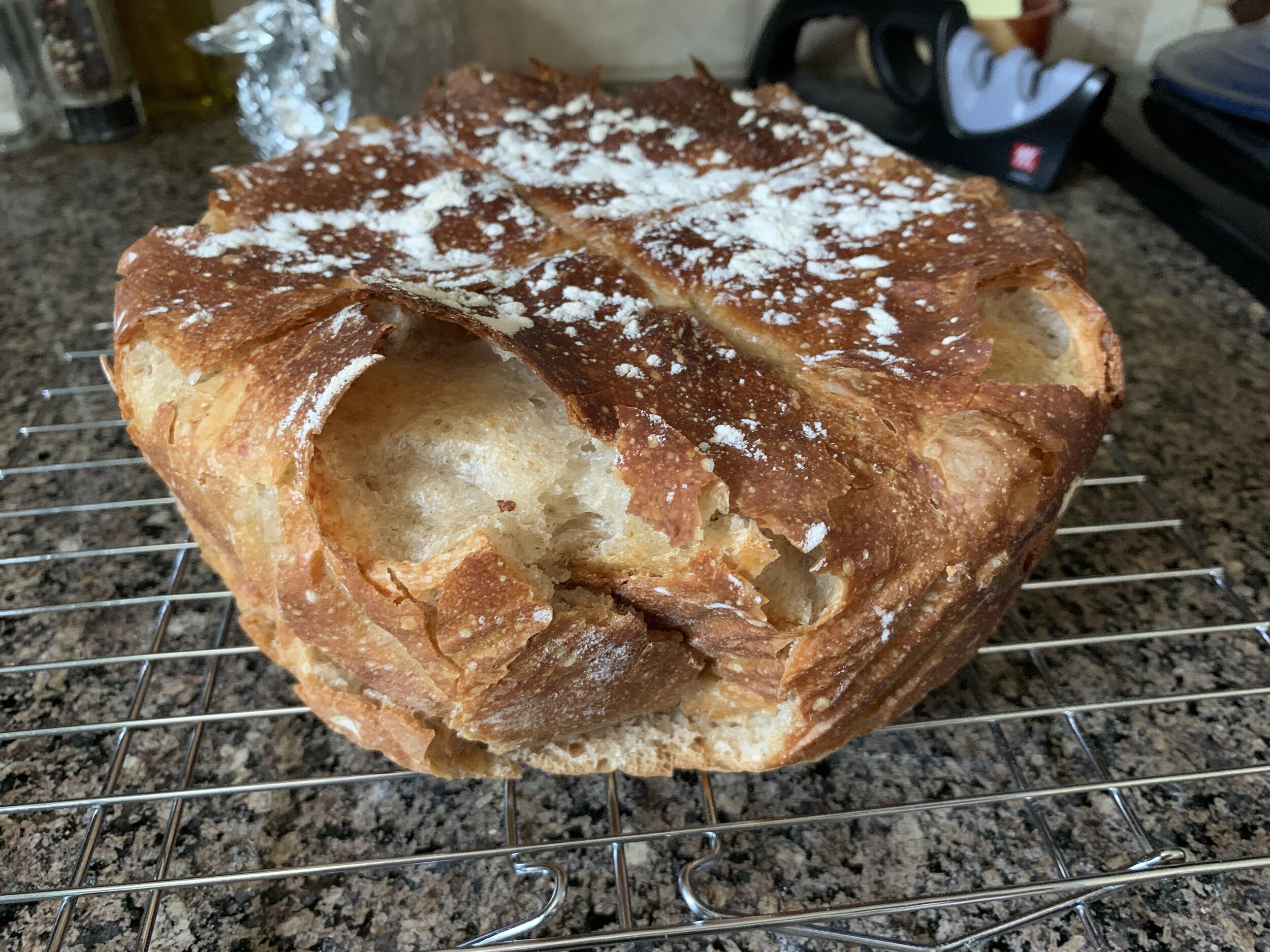Bread Fails. And Successes.
Photos from left to right: First loaves that were, er, not optimal; first sourdough loaf using the Dutch oven; abject and absolute failure of a loaf after several successful ones, for reasons (see below).
The problem with pandemic baking is you inevitably end up wasting that flour that is so difficult to find. Because sometimes you do something stupid. Or you don’t have the right tools. Or things just don’t work for no apparent reason and you end up with yet another entry in the Life’s Little Mysteries column.
As someone who doesn’t always appreciate a ton of narrative before you get to the damn recipe, I’m going to post the successful recipes (for me anyway) for starter and sourdough bread right here, both from King Arthur flour (I do have a few tips, that you can read about below).
Starter: https://www.kingarthurflour.com/recipes/sourdough-starter-recipe
Sourdough bread: https://www.kingarthurflour.com/recipes/no-knead-sourdough-bread-recipe
(caveat: I am truly a rookie at the bread thing. What works for me, may not work for you. So don’t hesitate to head to the Internets and do some research. I really like the King Arthur Flour site, as well as The Kitchn.)
Warning: Really. Long. Post. Starts. Here.
Notes on the Starter
Smells vinegary and sour, looks gross - perfect!
I actually did not follow this recipe. I had already started a starter (is that right?) using a recipe from the Reinhart book, and was finding the whole thing unnecessarily complicated and fussy. And then I watched the Late Show with Stephen Colbert and he was discussing bread baking with Jake Gyllenhaal and Gyllenhaal, who was looking unwashed and grungy yet still somehow adorable, was whispering that rye flour was key…so I started tossing in rye flour when I fed my starter. And then I fed it the artisan bread flour I got from White Lotus Farms via Jolly Pumpkin in Dexter, and then some all-purpose flour once or twice, and then I threw in some whole wheat flour. So, what I am saying here is that my starter is a real mongrel, and I am also possibly saying that anything goes. Your wild yeasties may not care what flavor of flour you give them to munch on and gas the place up.
What I found enlightening about this starter was the feeding schedule, which is basically equal parts flour and water and starter. So basic. So easy to adjust depending on how much starter you need. A real game-changer, honestly.
Also, the refrigerator is your friend here. I mean, we all have gobs of time on our hands, but feeding a starter every day, or every 12 hours…is not really how I want to spend it. Like, I just don’t think I should have to maintain a calendar for what is essentially a non-sentient being. At least, I hope it’s non-sentient. Anyway, feed your starter, let it grow for a few hours on the counter, and shove it in the fridge. Then feed it weekly - or don’t, it’s hard to kill, really.
Wow, I really do hope it’s non-sentient.
When you want to use it, set it on the counter. As it warms up, it should start to bubble and come back to life. If it seems sluggish, feed it and let it grow again at room temp, and you should be all set.
Notes on the Sourdough
The single biggest falutin’ deal here is the Dutch oven. As in, the difference in how your bread rises, crusts, looks and tastes using this method is so beyond extra, it’s practically The Rapture.
I literally squealed (“Nailed it!”) and danced around the kitchen when I took the cover off the baker the first time I made bread in it (see photo at beginning of this post).
Now, do you need the $350 Le Creuset Dutch oven? Well, no. Unless you want one. Honestly, any 5 qt oven-safe pot (to at least 450 degrees) with an oven-safe lid (although, foil could work just as well) will do the job. Fun fact about the Le Creuset lids - the standard black plastic knob is not high-heat-resistant! But hey, you can spend $20 more and get the metal one! Ergh.
Forget all the business about oiling the inside, and flouring and whatnot. Two words: parchment paper. Trust me on this. Your entire baking life will be so much better.
Now, YMMV, but I had to make some adjustments. As gorgeous as that first loaf was, the bottom was burnt. After some googling, I slid my baking stone onto the bottom rack after preheating the oven and that seemed to solve the problem. I also reduced the temp slightly - preheated at 450°, and reduced the baking temp from 450° to 435° - so I could get the longer bake (without a burnt crust) that I seemed to need to get the internal temperature to the 210° indicated in the recipe.
All of that took about 3 loaves. All attractive and edible, but not quite…there.
Bread Fail
Loaf four was a disaster. Big Bread Fail. The main culprit? Strawberry jam.
Failed bread looks like a failed soufflé too. Who knew?
I picked strawberries that morning. Placed the bread dough from fridge to Dutch oven before I left - and should have known there was a problem right away. No-knead bread dough is a little wet and sticky; this was even wetter, and I figured this was due to using regular bread flour instead of the heavier, higher-wheat content “artisan” flour I had been using. And it’s possible this was a factor. But off I went to pick berries.
Time-wise, the dough needed another hour before going into the oven when I got back. So, I preheated the oven, set my canning pot on the stove to heat up, and made jam.
You betcha there was a lot of heat in that kitchen.
I lifted the lid off the bread to score the top and this…enormous, white, bubbly, blobby thing was sitting there. (No, not THAT thing - this is the bread section, not the political section).
NOW I know that I could have dumped it all out, punched it down, reshaped it and plopped it back in the pot to rise a little and then baked it. BUT I DID NOT KNOW THAT THEN.
So I made a sad attempt to score the top and popped it in the oven.
The jam turned out fine.
Bread, not so much. In addition to the sad lumpy mess I had to pry out of the pot, it had no flavor at all.
The chickens were fine with it, however.
Loaf 5…
…made it’s brief appearance on WHMI and I forgot to taste it. But The Great Foodini was having a breadgasm while eating a slice slathered in my garlic-chive butter, so maybe it was adequate?
I need to make Loaf 6 to confirm, but the magic mix seems to be approximately half King Arthur unbleached bread flour and half White Lotus Farms unbleached bread flour. It’s a journey!
I’ll let you know!





